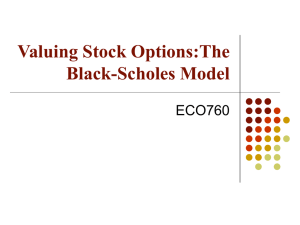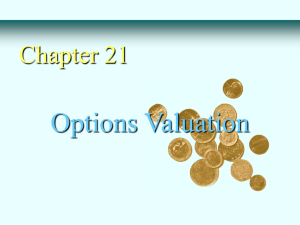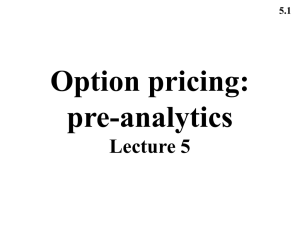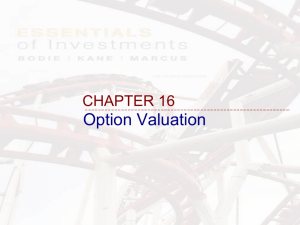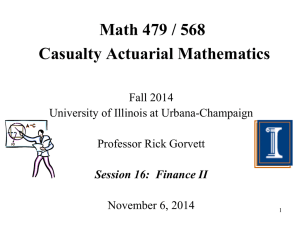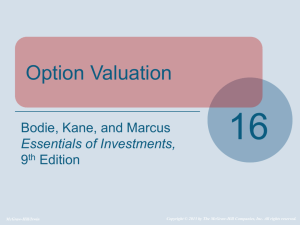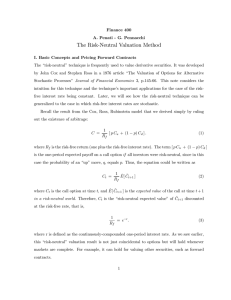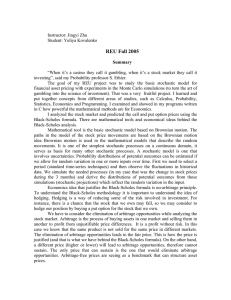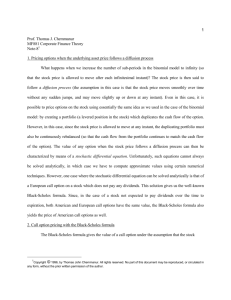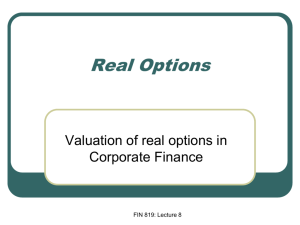The Black-Scholes Model - E
advertisement
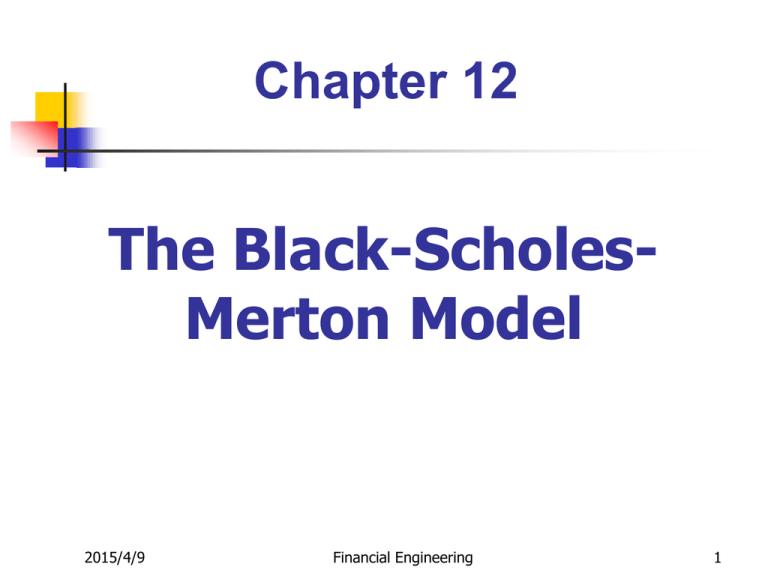
Chapter 12 The Black-ScholesMerton Model 2015/4/9 Financial Engineering 1 The Stock Price Assumption Consider a stock whose price is S dS=μSdt+σSdz dS/S= μdt+σdz ? dlnS= μdt+σdz No. From Ito’s lemma, dlnS= (μ- σ2/2)dt+σdz 2015/4/9 Financial Engineering 2 The Lognormal Property It follows from this assumption that 2 ~ 2 T , T 2 ~ ln S 0 2 T , T ln S T ln S 0 or ln S T Since the logarithm of ST is normal, ST is lognormally distributed 2015/4/9 Financial Engineering 3 The Lognormal Distribution E (ST ) S0 e T var ( S T ) S 0 e 2 2015/4/9 2 T 2 (e T 1) Financial Engineering 4 Continuously Compounded Return (Equations 13.6 and 13.7), page 279) If x is the continuously compounded return ST S 0 e 1 ST x= ln T S0 xT 2 2 x 2 , T 5 The Expected Return The expected value of the stock price is S0eT The expected return on the stock is – 2/2 E ln( ST / S 0 ) ( / 2)T 2 ln E ( ST / S 0 ) T 2015/4/9 Financial Engineering 6 and −2/2 Suppose we have daily data for a period of several months is the average of the returns in each day [=E(DS/S)] −2/2 is the expected return over the whole period covered by the data measured with continuous compounding (or daily compounding, which is almost the same) 2015/4/9 Financial Engineering 7 Mutual Fund Returns (See Business Snapshot 13.1 on page 281) Suppose that returns in successive years are 15%, 20%, 30%, -20% and 25% The arithmetic mean of the returns is 14% The returned that would actually be earned over the five years (the geometric mean) is 12.4% 2015/4/9 Financial Engineering 8 The Volatility The volatility of an asset is the standard deviation of the continuously compounded rate of return in 1 year The standard deviation of the return in time Dt is D t If a stock price is $50 and its volatility is 25% per year what is the standard deviation of the price change in one day? 2015/4/9 Financial Engineering 9 Estimating Volatility from Historical Data 1. Take observations S0, S1, . . . , Sn at intervals of t years 2. Define: Si u i ln S i 1 3. Calculate the standard deviation, s , of the ui ´s s 4. The historical volatility estimate is: * t 2015/4/9 Financial Engineering 10 Nature of Volatility Volatility is usually much greater when the market is open (i.e. the asset is trading) than when it is closed For this reason time is usually measured in “trading days” not calendar days when options are valued 11 The Concepts Underlying Black-Scholes 2015/4/9 The option price & the stock price depend on the same underlying source of uncertainty We can form a portfolio consisting of the stock and the option which eliminates this source of uncertainty The portfolio is instantaneously riskless and must instantaneously earn the risk-free rate This leads to the Black-Scholes differential equation Financial Engineering 12 Assumptions of BS Formula The short-term interest rate is known and is constant through time. The stock price follows a random walk in continuous time with a variance rate proportional to the square of the stock price.Thus the distribution of stock prices is lognormal. The variance rate of the return on the stock is constant. The sock pays no dividends. The option is “European”. There are no transaction costs. It’s possible to borrow money to buy stocks. There are no penalties to short selling. 2015/4/9 Financial Engineering 13 The Derivation of the Black-Scholes Differential Equation 1 of 3: DS S Dt S Dz 2 ƒ ƒ ƒ 2 2 ƒ Dƒ S ½ S Dt S Dz 2 t S S S W e se t u p a p o rtfo lio co n sistin g o f 1: d e riva tive + 2015/4/9 ƒ S : sh a re s Financial Engineering 14 The Derivation of the Black-Scholes Differential Equation 2 of 3: T h e va lu e o f th e p o rtfo lio is give n b y ƒ ƒ S S T h e ch a n ge in its va lu e in tim e D t is give n b y D D ƒ 2015/4/9 ƒ S DS Financial Engineering 15 The Derivation of the Black-Scholes Differential Equation 3 of 3: The return on the portfolio must be the risk-free rate. Hence D rD t (t ) (0 ) e rt ln ( t ) ln ( 0 ) rt d rdt We substitute forD f andD S in these equations to get the Black-Scholes differential equation: 2 f 2 2 1 rS S rf 2 2 t S S f 2015/4/9 f Financial Engineering 16 The Differential Equation Any security whose price is dependent on the stock price satisfies the differential equation The particular security being valued is determined by the boundary conditions of the differential equation In a forward contract the boundary condition is ƒ = S – K when t =T The solution to the equation is ƒ = S – K e–r (T 2015/4/9 –t) Financial Engineering 17 Risk-Neutral Valuation The variable does not appear in the BlackScholes equation The equation is independent of all variables affected by risk preference The solution to the differential equation is therefore the same in a risk-free world as it is in the real world This leads to the principle of risk-neutral valuation 2015/4/9 Financial Engineering 18 Applying Risk-Neutral Valuation 1. Assume that the expected return from the stock price is the risk-free rate 2. Calculate the expected payoff from the option 3. Discount at the risk-free rate 2015/4/9 Financial Engineering 19 Valuing a Forward Contract with Risk-Neutral Valuation Payoff is ST – K Expected payoff in a risk-neutral world is S0erT – K Present value of expected payoff is e-rT[S0erT – K]=S0 – Ke-rT 20 The Black-Scholes Formulas c S0 N (d1 ) X e p X e w h e re rT 2015/4/9 N (d 2 ) N ( d 2 ) S0 N ( d1) d1 d2 rT ln( S 0 / X ) ( r 2 / 2)T T ln( S 0 / X ) ( r 2 T Financial Engineering / 2)T d1 T 21 The N(x) Function N(x) is the probability that a normally distributed variable with a mean of zero and a standard deviation of 1 is less than x See tables at the end of the book 22 Properties of Black-Scholes Formula As S0 becomes very large c tends to S0 – Ke-rT and p tends to zero • As S0 becomes very small c tends to zero and p tends to Ke-rT – S0 23 BS公式的推导(1) 在风险中性世界中 , 假定 : dS rSdt Sdz ln S T 2 ~ ln S 0 r T , 2 根据风险中性定价原理 c e rT T : rT Eˆ [max( S T X , 0 )] e X (S T X ) g ( S T ) dS T r T 2 2 ln S T 的均值 m 等于 : m Eˆ ln( S T ) ln S 0 令Q ln S T m T 显然 , Q ~ ( 0 ,1), 其概率密度函数为 2015/4/9 Financial Engineering : h (Q ) 1 2 e Q 2 /2 24 BS公式的推导(2) 将上述对ST的积分转换成对Q的积分,有: Eˆ [max( S T X , 0 )] e (ln X m ) / e TQm 1 e 2 TQm (e (ln X m ) / h ( Q ) dQ X [ ( Q 1 2 2 2 e TQm X ) h ( Q ) dQ T T h (Q ) ( Q 2 h ( Q ) dQ (ln X m ) / T TQ2m )/ 2 2 T ) T 2 m ] / 2 2 e m T / 2 2 e [ ( Q 2 T ) ]/ 2 e 2 m T / 2 h (Q T) Eˆ [max( S T X , 0 )] e 2015/4/9 2 m T / 2 h (Q (ln X m ) / T ) dQ X T Financial Engineering h ( Q ) dQ (ln X m ) / T 25 BS公式的推导(3) h (Q (ln X m ) / T ) dQ 1 N [(ln X m ) / T T] T N [( ln X m ) / T T ] N[ ln( S 0 / X ) ( r / 2 )T 2 ln[ Eˆ ( S T ) / X ] / 2 ] T 2 N[ 同样 , (ln X m ) / T ] N (d1 ) ln( S 0 / X ) ( r / 2 )T 2 h ( Q ) dQ N [ m Eˆ [max( S T X , 0 )] e 2 T T ] N (d 2 ) N ( d 1 ) XN ( d 2 ) Eˆ ( S T ) N ( d 1 ) XN ( d 2 ) S 0 e N ( d 1 ) XN ( d 2 ) rT c S 0 N (d1 ) e 2015/4/9 rT XN ( d 2 ) Financial Engineering 26 BS公式的解释 S0N(d1)是Asset-or-noting call option的价值, -e-rTXN(d2)是X份cash-or-nothing看涨期权空 头的价值。 N(d2)是在风险中性世界中期权被执行的概率, 或者说ST大于X的概率, e-rTXN(d2)是X的风险 中性期望值的现值。 S0N(d1)是得到ST的风险 中性期望值的现值。 D N ( d 1 )是复制交易策略中股票的数量, S0N(d1)就是股票的市值, -e-rTXN(d2)则是复 制交易策略中负债的价值。 2015/4/9 Financial Engineering 27 Implied Volatility The implied volatility of an option is the volatility for which the Black-Scholes price equals the market price The is a one-to-one correspondence between prices and implied volatilities Traders and brokers often quote implied volatilities rather than dollar prices 2015/4/9 Financial Engineering 28 Causes of Volatility Volatility is usually much greater when the market is open (i.e. the asset is trading) than when it is closed For this reason time is usually measured in “trading days” not calendar days when options are valued 2015/4/9 Financial Engineering 29 The VIX S&P500 Volatility Index Chapter 24 explains how the index is calculated 30 Warrant Valuation The analysis of warrants is much more complicated than that of options, because: The life of a warrant is typically measured in years, rather than in months, so the variance rate may change substantially. The Exercise price of the warrant is usually not adjusted at all for dividends. The exercise price of a warrant sometimes changes on specified dates. If the company is involved in a merger, the adjustment that is made in the terms of the warrant may change its value. The exercise of a large number of warrants may sometimes result in a significant increase in the 2015/4/9 Financial Engineering 31 number of common shares outstanding. Warrants & Dilution When a regular call option is exercised the stock that is delivered must be purchased in the open market When a warrant is exercised new stock is issued by the company If little or no benefits are foreseen by the market the stock price will reduce at the time the issue of is announced. There is no further dilution (See Business Snapshot 13.3.) 2015/4/9 Financial Engineering 32 Warrant Valuation 某公司有N股普通股和M份欧式认股权证, 每份权证可以在T时刻按每股X价格购买b 股股票.令S表示公司股票价格,则认股 权证被行使后股票的除权价格为: NS T MbX 认股权证持有者的回报为: max[ b( 2015/4/9 NS T MbX N Mb X ),0 ] Nb N Mb Financial Engineering N Mb max( S T X ,0 ) 33 Dividends European options on dividend-paying stocks are valued by substituting the stock price less the present value of dividends into Black-Scholes Only dividends with ex-dividend dates during life of option should be included The “dividend” should be the expected reduction in the stock price expected 2015/4/9 Financial Engineering 34 American Calls An American call on a non-dividend-paying stock should never be exercised early An American call on a dividend-paying stock should only ever be exercised immediately prior to an ex-dividend date 2015/4/9 Financial Engineering 35 Black’s Approach to Dealing with Dividends in American Call Options Set the American price equal to the maximum of two European prices: 1. The 1st European price is for an option maturing at the same time as the American option 2. The 2nd European price is for an option maturing just before the final exdividend date 2015/4/9 Financial Engineering 36
